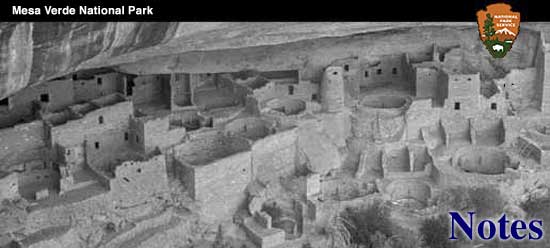

|
Though not included within the real cactus area of the Southwest, the Mesa Verde has a number of species of cacti which merit attention. As typical with most cacti, these species remain inconspicuous and unnoticed most of the year until May and June when suddenly, as if indignant over their ignoble inconspicuousness, they burst into bloom to fill the mesas and canyons with their beauty. One of the first to blossom is the Devil's Claw or Braided arrow, as the Navajos call it, or technically Sclerocactus whipplei (Engelm & Bigelow) B. & G. It may be immediately recognized by its central spines, one of which is straight and pointed upwards and the other three of which are either all hooked and outwards, or, at least, one is hooked and the others are straight. The spines are gray or brown in color. Seven to eleven radial spines surround the central ones and are of the same color. Upon examining the stem or joint of this cactus it appears to be tuberculate, but upon closer examination it is seen to be vertically ribbed with the tubercles arising from the ribs. The fruit opens at the base when dry to release the the large knobby black seeds.
In the autumn the stems assume a reddish appearance and it is then that the Navajos roast the entire plant in ashes, after the spines have been burned off and prepare a palatable dish of the roasted stems by slicing them and adding salt. Laura Adams Armer states1 that the above prepared dish "is mild and pleasant and has the consistency of shreded pineapple."
In late May and early June, beneath the pinyon and juniper, occasional clumps of Echinocereus coccineus-Engelm. are found with their scarlet blossoms arising from the sides of the plant. The Navajos call this the Heart twister. This is the only representative of the Echinocereanae subtribe. The spines are straight and yellow in color. Its identification is simple, for even if the plant is not blossoming, the fresh fruit, the shriveled-up fruit from last season, or the mark where the fruit was indicates where the blossoms were. There are one to three central spines and eight to twelve radial ones. The short hairs from the flower scales serve to distinguish Echinocereus coccineus from E. polyacanthus which has long cobwebby hairs from its flower scales. According to the Navajos2 the fruit of this Heart Twister tempted them during the original wanderings of the tribe, when they were dependent upon the fruit of desert plants for sustenance. They ate of this juicy fruit, which smells like strawberries, and their hearts were twisted in pain. Since then it has been the custom to offer hair of the head to this cactus before eating its fruit. The hair is offered with the following supplication: "Be good, little cactus fruit and do not twist my heart." Common names which cactus fanciers have given the Heart twister of the Navajos are quite numerous and include: Scarlet-flowered hedgehog, porcupine, pickle or torch cactus.
Blossoming at the same time as the Heart Twister is the Arizona Pincushion or Sour Cactus (Coryphantha arizonica (Engelm.) B. & R.), one of the most delightful of the cacti. Its purple-pink blossoms from the top of the plant sometimes nearly hide the stem beneath. One wonders at times just how the smaller stems could possibly give rise to the large flowers which they do. To identify this Sour Cactus is simple as each of its tubercles has a groove running down its upper side, which places it in its genus Coryphantha, and the flowers have their inner petals wider below the middle, making them lance-shaped. The plants are usually clustered. The Navajos3 delight in eating the pleasantly sour berries, and also dry them in the sun to be stored away. It is also used by the Navajos in their Lightning Chant.
Two Opuntias of the Platyopuntia, or flat-stemmed cacti, are known on the Mesa Verde. Both may be immediately recognized by the flat stems or joints. They may be easily differentiated. Opuntia phaeacantha-Engelm. is a larger stemmed, sparser and shorter spined plant, having its spines restricted to the upper half or third of the joint. Opuntia polychantha Haworth has its numerous spines growing right down to the base of the joint. As the name Opuntia phaeacantha implies, this species usually has brown spines, though the color may quite often be gray, yellow or red. The joints are less than six inches broad and are broadly obovate to round. The fruit is juicy.
Concerning Opuntia polyacantha, its fruit is dry and its gray spines are as much as two inches in length. One of the most characteristic things about this species is its wrinkled and cross-checked joints. Because of the fruit being dry with no pulp and no juice, nothing but hard seeds, the Navahos call it Hunger Cactus. It is not one of the "good" Cactus People.
O. phaeacantha, however, is one of the "good" Cactus People for its pear-shaped juicy fruit is quite delicious. When the fruit (tunas) is eaten it is impaled upon a wooden skewer the spines are cut off and the fruit is eaten fresh or it may be cooked. The fruit may also be dried and then cooked when desired. TO BE CONTINUED | ||||||
| <<< Previous | > Cover < | Next >>> |
vol5-2c.htm
14-Oct-2011